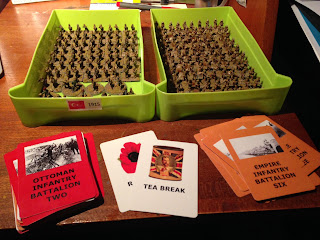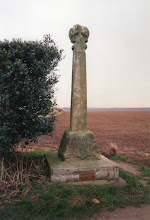I've been dead keen to give If the Lord Spares Us a run now that I have a regiment of British infantry and the equivalent for the Ottoman Empire. However, every time I get a game set up and have done the obligatory quick re-read of the rules, it's well after midnight.
Anyway, here's a few pictures of the last attempt - abandoned after a few turns. A full British brigade was assulting an Ottoman force of two under-strength Taburs (battalions) entrenched on high ground in front of an oasis.
It's late in 1915, and the British infantry are faced with the job of carrying through the assault or being stuck without water. A wadi snakes across the board just in front of the British deployment zone. I've included the 'Water, water!" card as a part of the deck to introduce the impact of limited water supply for the troops. This seems to have been a constant feature of the Sinai campaign.
Both Ottoman taburs were rated as 'Johnny Turks' and the assaulting British had one battalion of 'Jolly Good Fellows' (regulars) and two battalions of 'Saturday Boys'. (territorials) All units were deployed as blinds with one dummy blind added to each side.
 |
| A Turkish blind was placed on the entrenchments near the oasis in the foreground, but early British scouting only encountered patrols in the area. The advance continued in ernest. |
 |
| Quickly the British infantry occupied the wadi, providing the last cover before the assault on the high ground. |
 |
| Small arms fire from Hill 175 (on the far right) caused some suppression of the British centre - but a fortunate turn up of the 'stiff upper lip' card, overcame this early reverse. |
 |
| On the British left, fire from the wadi started to tell on the defenders of Hill 150 (on the left) suppressing the defenders. |
 |
| A sweeping view of the British Brigade awaiting the whistle's call to advance again. |
Even in these early turns, I could see the difficulties caused by assaulting fixed positions – with the Turkish machine guns able to fire on every activation. The British MGs were largely silent having moved each turn on which the battalions were activated (thus, unable to fire). Some artillery support would have balanced up the situation, somewhat.
Summer holidays begin this week. I'm sure to get back to this scenario soon. Until we meet again, if the Lord spares us!

















































